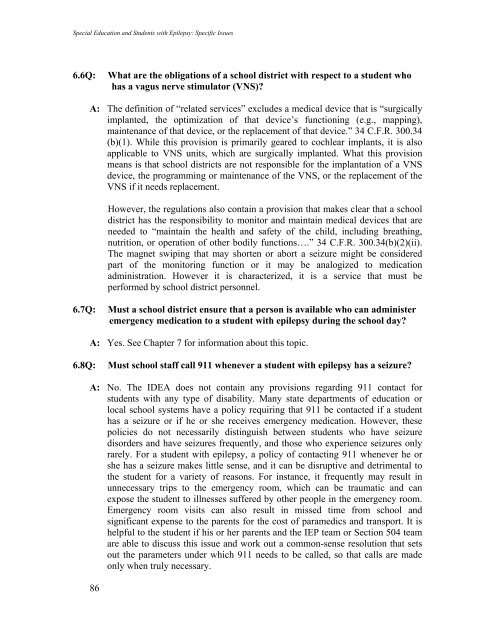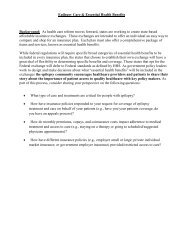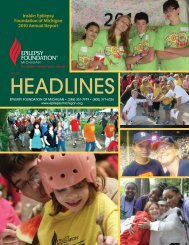Legal Rights of Children with Epilepsy in School & Child Care
Legal Rights of Children with Epilepsy in School & Child Care
Legal Rights of Children with Epilepsy in School & Child Care
Create successful ePaper yourself
Turn your PDF publications into a flip-book with our unique Google optimized e-Paper software.
Special Education and Students <strong>with</strong> <strong>Epilepsy</strong>: Specific Issues<br />
6.6Q:<br />
What are the obligations <strong>of</strong> a school district <strong>with</strong> respect to a student who<br />
has a vagus nerve stimulator (VNS)?<br />
A: The def<strong>in</strong>ition <strong>of</strong> “related services” excludes a medical device that is “surgically<br />
implanted, the optimization <strong>of</strong> that device’s function<strong>in</strong>g (e.g., mapp<strong>in</strong>g),<br />
ma<strong>in</strong>tenance <strong>of</strong> that device, or the replacement <strong>of</strong> that device.” 34 C.F.R. 300.34<br />
(b)(1). While this provision is primarily geared to cochlear implants, it is also<br />
applicable to VNS units, which are surgically implanted. What this provision<br />
means is that school districts are not responsible for the implantation <strong>of</strong> a VNS<br />
device, the programm<strong>in</strong>g or ma<strong>in</strong>tenance <strong>of</strong> the VNS, or the replacement <strong>of</strong> the<br />
VNS if it needs replacement.<br />
However, the regulations also conta<strong>in</strong> a provision that makes clear that a school<br />
district has the responsibility to monitor and ma<strong>in</strong>ta<strong>in</strong> medical devices that are<br />
needed to “ma<strong>in</strong>ta<strong>in</strong> the health and safety <strong>of</strong> the child, <strong>in</strong>clud<strong>in</strong>g breath<strong>in</strong>g,<br />
nutrition, or operation <strong>of</strong> other bodily functions….” 34 C.F.R. 300.34(b)(2)(ii).<br />
The magnet swip<strong>in</strong>g that may shorten or abort a seizure might be considered<br />
part <strong>of</strong> the monitor<strong>in</strong>g function or it may be analogized to medication<br />
adm<strong>in</strong>istration. However it is characterized, it is a service that must be<br />
performed by school district personnel.<br />
6.7Q:<br />
Must a school district ensure that a person is available who can adm<strong>in</strong>ister<br />
emergency medication to a student <strong>with</strong> epilepsy dur<strong>in</strong>g the school day?<br />
A: Yes. See Chapter 7 for <strong>in</strong>formation about this topic.<br />
6.8Q:<br />
Must school staff call 911 whenever a student <strong>with</strong> epilepsy has a seizure?<br />
A: No. The IDEA does not conta<strong>in</strong> any provisions regard<strong>in</strong>g 911 contact for<br />
students <strong>with</strong> any type <strong>of</strong> disability. Many state departments <strong>of</strong> education or<br />
local school systems have a policy requir<strong>in</strong>g that 911 be contacted if a student<br />
has a seizure or if he or she receives emergency medication. However, these<br />
policies do not necessarily dist<strong>in</strong>guish between students who have seizure<br />
disorders and have seizures frequently, and those who experience seizures only<br />
rarely. For a student <strong>with</strong> epilepsy, a policy <strong>of</strong> contact<strong>in</strong>g 911 whenever he or<br />
she has a seizure makes little sense, and it can be disruptive and detrimental to<br />
the student for a variety <strong>of</strong> reasons. For <strong>in</strong>stance, it frequently may result <strong>in</strong><br />
unnecessary trips to the emergency room, which can be traumatic and can<br />
expose the student to illnesses suffered by other people <strong>in</strong> the emergency room.<br />
Emergency room visits can also result <strong>in</strong> missed time from school and<br />
significant expense to the parents for the cost <strong>of</strong> paramedics and transport. It is<br />
helpful to the student if his or her parents and the IEP team or Section 504 team<br />
are able to discuss this issue and work out a common-sense resolution that sets<br />
out the parameters under which 911 needs to be called, so that calls are made<br />
only when truly necessary.<br />
86








